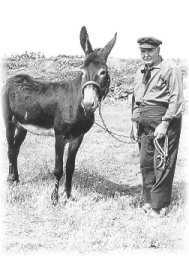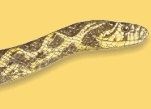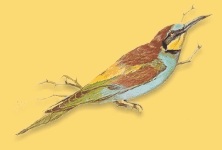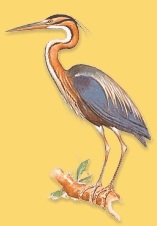The Fauna of Pantelleria island
The fauna of Pantelleria is unique
because of its geographical position which has isolated the species of the island,
allowing the development and growth of endemisms, and the conservation of other species
which are rare or extinct in other parts of the world.
 The
Pantescan Donkey (U Sceccu in local
dialect), already well known in the first century B.C., was very common on the island
until a few decades ago. The main features of this donkey were the height at the withers,
which could reach 140 cm. and the unusual amble (camel-like) walk. Because of its robust
and slender body the donkey played an important role in the development of the
island’s viticulture as it could carry many loads along the steep paths; the donkey
was so precious to the peasants that they were kept in their own stables, called locally
‘sarduni’. Another animal always found in peasant
life is the Pantescan goat, unfortunately almost extinct. It was probably the first
domestic to be introduced into the island by prehistoric populations, and it has adapted
and avolved into an exceptionally robust animal. The
Plecotus Bat, called locally
‘Tallarita i notte’ (night swallow) is expecially common in the natural caves in
Gelfiser. The wild rabbit (Oryctolagus Cuniculus) is very diffuse, and can be easily seen
along mountain paths after sunset. Very valuable are the rare sightings of wildcats (felix
silvestri). The
Pantescan Donkey (U Sceccu in local
dialect), already well known in the first century B.C., was very common on the island
until a few decades ago. The main features of this donkey were the height at the withers,
which could reach 140 cm. and the unusual amble (camel-like) walk. Because of its robust
and slender body the donkey played an important role in the development of the
island’s viticulture as it could carry many loads along the steep paths; the donkey
was so precious to the peasants that they were kept in their own stables, called locally
‘sarduni’. Another animal always found in peasant
life is the Pantescan goat, unfortunately almost extinct. It was probably the first
domestic to be introduced into the island by prehistoric populations, and it has adapted
and avolved into an exceptionally robust animal. The
Plecotus Bat, called locally
‘Tallarita i notte’ (night swallow) is expecially common in the natural caves in
Gelfiser. The wild rabbit (Oryctolagus Cuniculus) is very diffuse, and can be easily seen
along mountain paths after sunset. Very valuable are the rare sightings of wildcats (felix
silvestri).
REPTILES
The island’s species of reptile
offer a more interesting study. Two rare species which can be found are the ‘Colubro
Ferro di cavallo’ (literally horse-shoe coluber, scientific name Coluber Ippocrepis),
which is found only in Pantelleria and Sardinia and is considered Europe’s most
beautiful snake because of it’s colours, the other rare reptile is the green tortoise
(testudo graeca), locally called tortuca. The colony of tortoises in Pantelleria is one of
the few today still in its natural state (it is completely extinct in its natural state in
the rest of Sicily). The sicilian lizards (locally called ‘Sarmucela’) run
about the island’s stone walls together with the geckos (locally called
‘Cucciarda tignusa’), both perfectly camouflaged. Other reptiles include the
coluber, whose coloured species reminds one of obsidian stone, and the gongilo (called
sangumia) which lives under the stones.
INVERTEBRATES
 Among the invertebrates of Pantelleria, although both European and African species are present on the island, it is worth
mentioning the following endemic subspecies: a melliporous bee probably of african origin,
which can be distinguished from other bees for its dark colour and
aggressiveness, and the
grilled talpa (literally cricket mole), which lives in a confined area around the lake
called ‘Specchio di Venere’ (Venus’ mirror). Among the invertebrates of Pantelleria, although both European and African species are present on the island, it is worth
mentioning the following endemic subspecies: a melliporous bee probably of african origin,
which can be distinguished from other bees for its dark colour and
aggressiveness, and the
grilled talpa (literally cricket mole), which lives in a confined area around the lake
called ‘Specchio di Venere’ (Venus’ mirror).
BIRDS
 A visit to the beautiful lake is recommended
to all bird watchers, as it is frequented by many varied
species: the small
blackcap
(locally ‘fatascia’) and other sparrowlike specimens; the stilt-bird, as elegant
as the grey heron, the pink flamingo and the crane. Because Pantelleria is between Europe
and Africa, it is used as a bridge by many migrating birds, such as the rare
falco della
regina (literally queen’s falcon, scientific name falco eleonorate), whose black
silhouette is sometimes seen on the island; other species of falcon include the brown
kite, the pelegrine falcon, the buzzard and the hen harrier. One must not miss these large
flocks of A visit to the beautiful lake is recommended
to all bird watchers, as it is frequented by many varied
species: the small
blackcap
(locally ‘fatascia’) and other sparrowlike specimens; the stilt-bird, as elegant
as the grey heron, the pink flamingo and the crane. Because Pantelleria is between Europe
and Africa, it is used as a bridge by many migrating birds, such as the rare
falco della
regina (literally queen’s falcon, scientific name falco eleonorate), whose black
silhouette is sometimes seen on the island; other species of falcon include the brown
kite, the pelegrine falcon, the buzzard and the hen harrier. One must not miss these large
flocks of
 birds in spring time, soaring over the sea, carried by air
currents. It is quite
common to see the profile of the ‘capovaccaro’ (of the vulture family) or some
eagle subspecies such as the ‘bonelli’ eagle or the
harrier eagle. The unique
species of falcon in Pantelleria is the kestrel, called locally ‘sicarro’, which
is found in big colonies along the island’s cliffs. Other rare birds which are
frequent visitors to Pantelleria are the bee-eater (vocally called ‘scilakila’,
scientific name merops apiaster), the marine jay, the moore
(called ‘catabubbo’
in dialect), the oriole (‘ghiannuni’); all these birds are mightly appreciated
for their coloured plumage. Among the more common species found in Pantelleria are
the
thrush, the blackbirds, the woodcock, and the
quail. Among the wading birds are the grey
heron, the red heron, the nitticora, the gazzetta
ciuffetto, the cavaliere d’italia,
the avocetto, and the crane. It has to be mentioned that the Montagna
Grande (Big
Mountain) is the only European site where the algerian tit and the rare
beccamoschino make
their nests. birds in spring time, soaring over the sea, carried by air
currents. It is quite
common to see the profile of the ‘capovaccaro’ (of the vulture family) or some
eagle subspecies such as the ‘bonelli’ eagle or the
harrier eagle. The unique
species of falcon in Pantelleria is the kestrel, called locally ‘sicarro’, which
is found in big colonies along the island’s cliffs. Other rare birds which are
frequent visitors to Pantelleria are the bee-eater (vocally called ‘scilakila’,
scientific name merops apiaster), the marine jay, the moore
(called ‘catabubbo’
in dialect), the oriole (‘ghiannuni’); all these birds are mightly appreciated
for their coloured plumage. Among the more common species found in Pantelleria are
the
thrush, the blackbirds, the woodcock, and the
quail. Among the wading birds are the grey
heron, the red heron, the nitticora, the gazzetta
ciuffetto, the cavaliere d’italia,
the avocetto, and the crane. It has to be mentioned that the Montagna
Grande (Big
Mountain) is the only European site where the algerian tit and the rare
beccamoschino make
their nests.
|
